A Review of Stator Insulation State-of-Health Monitoring Methods
Abstract
1. Introduction
1.1. Background
1.2. Contributions and Organization of This Review
2. Partial Discharge Tracking
3. Offline SoH Tracking Methods
3.1. Insulation Capacitance Testing
3.2. Dissipation Factor (DF) Testing
3.3. Insulation Resistance Testing
3.4. Surge Testing
4. Online SoH Tracking Methods
4.1. Online Tracking of Insulation Impedance
4.2. Online Current Analysis Methods
4.3. Artificial Intelligence Approaches for SoH Tracking and Diagnostics
5. Comparative Evaluation of SoH Methods
6. Conclusions
Author Contributions
Funding
Data Availability Statement
Conflicts of Interest
Abbreviations
| SoH | State of Health |
| WBG | Wide Bandgap |
| PD | Partial Discharge |
| DF | Dissipation Factor |
| IR | Insulation Resistance |
| PI | Polarization Index |
| HF | High Frequency |
| RUL | Remaining Useful Life |
| RMSD | Root Mean Square Deviation |
| ISI | Insulation State Indicator |
| TT | Turn to Turn |
| GW | Groundwall |
| AI | Artificial Intelligence |
References
- Boulter, E.A.; Stone, G.C. Historical Development of Rotor and Stator Winding Insulation Materials and Systems. IEEE Electr. Insul. Mag. 2004, 20, 25–39. [Google Scholar] [CrossRef]
- Petri, T.; Keller, M.; Parspour, N. The Insulation Resilience of Inverter-Fed Low Voltage Traction Machines: Review, Challenges, and Opportunities. IEEE Access 2022, 10, 104023–104049. [Google Scholar] [CrossRef]
- Paul, S.K.; Maur, S.; Biswas, S.; Pradhan, A.K. Review on Thermal and Electrical Properties for Condition Assessment of Epoxy Nano- Composites by Advanced Techniques. IEEE Trans. Dielectr. Electr. Insul. 2024, 31, 230–245. [Google Scholar] [CrossRef]
- Morya, A.; Toliyat, H.A. Insulation Design for Wide Bandgap (WBG) Device Based Voltage Source Converter Fed Motors. In Proceedings of the 2017 IEEE 5th Workshop on Wide Bandgap Power Devices and Applications (WiPDA), Albuquerque, NM, USA, 30 October–1 November 2017; pp. 74–79. [Google Scholar]
- Moghadam, D.E.; Speck, J.; Grossmann, S.; Stahl, J. Introducing of a Test Sample for IEC/TS 60034-18-42 to Assess the Durability of the Turn Insulation. In Proceedings of the 2018 IEEE 2nd International Conference on Dielectrics (ICD), Budapest, Hungary, 1–5 July 2018; pp. 1–5. [Google Scholar]
- Binder, A.; Schneider, T. High-Speed Inverter-Fed AC Drives. In Proceedings of the 2007 International Aegean Conference on Electrical Machines and Power Electronics, Bodrum, Turkey, 10–12 September 2007; pp. 9–16. [Google Scholar]
- Walden, K. The Use and Proper Selection of Variable Speed Drives (VSD) for Reduced Environmental Footprint, Sustainability and Increased Plant Reliability. In Proceedings of the 2011 IEEE-IAS/PCA 53rd Cement Industry Technical Conference, St. Louis, MO, USA, 22–26 May 2011; pp. 1–9. [Google Scholar]
- Ellis, R.G.; Seggewiss, J.G.; Paes, R.H.; Kay, J.A. Methods for the Control of Large Medium-Voltage Motors: Application Considerations and Guidelines. IEEE Trans. Ind. Appl. 2000, 36, 1688–1696. [Google Scholar] [CrossRef]
- Khan, Q.; Refaat, S.S.; Abu-Rub, H.; Toliyat, H.A. Partial Discharge Modeling of Internal Discharge in Electrical Machine Stator Winding. In Proceedings of the 2020 IEEE Kansas Power and Energy Conference (KPEC), Manhattan, KS, USA, 13–14 July 2020; pp. 1–6. [Google Scholar]
- Kaufhold, M.; Aninger, H.; Berth, M.; Speck, J.; Eberhardt, M. Electrical Stress and Failure Mechanism of the Winding Insulation in PWM-Inverter-Fed Low-Voltage Induction Motors. IEEE Trans. Ind. Electron. 2000, 47, 396–402. [Google Scholar] [CrossRef]
- Xiong, H.; Liu, R.; Hu, B.; You, H.; Wei, Z.; Zhang, J.; Wang, J. The Ohio State University Partial Discharge Detection Platform for Electric Machine Windings Driven by PWM Voltage Excitation. In Proceedings of the 2019 IEEE Electrical Insulation Conference (EIC), Calgary, AB, Canada, 16–19 June 2019; pp. 517–520. [Google Scholar]
- Stranges, M.K.W.; Stone, G.C.; Bogh, D.L. IEC 60034-18-41: A New Draft Technical Specification for Qualification and Acceptance Tests of Inverter Duty Motor Insulation. In Proceedings of the Record of Conference Papers Industry Applications Society 52nd Annual Petroleum and Chemical Industry Conference, Denver, CO, USA, 12–14 September 2005; pp. 297–302. [Google Scholar]
- Johannesson, D.; Nawaz, M.; Ilves, K. Assessment of 10 kV, 100 A Silicon Carbide mosfet Power Modules. IEEE Trans. Power Electron. 2018, 33, 5215–5225. [Google Scholar] [CrossRef]
- Ding, R.; Dou, Z.; Qi, Y.; Mei, W.; Liu, G. Analysis on Characteristic of 3.3-kV Full SiC Device and Railway Traction Converter Design. IET Power Electron. 2022, 15, 978–988. [Google Scholar] [CrossRef]
- Lee, W.; Li, S.; Han, D.; Sarlioglu, B.; Minav, T.A.; Pietola, M. A Review of Integrated Motor Drive and Wide-Bandgap Power Electronics for High-Performance Electro-Hydrostatic Actuators. IEEE Trans. Transp. Electrif. 2018, 4, 684–693. [Google Scholar] [CrossRef]
- Mocevic, S.; Yu, J.; Fan, B.; Sun, K.; Xu, Y.; Stewart, J.; Rong, Y.; Song, H.; Mitrovic, V.; Yan, N.; et al. Design of a 10 kV SiC MOSFET-Based High-Density, High-Efficiency, Modular Medium-Voltage Power Converter. iEnergy 2022, 1, 100–113. [Google Scholar] [CrossRef]
- YG PRESS NEWS—Power SiC: A $10B Market by 2029 Facing Short-Term Turbulence. Yole Group, 10 September 2024.
- He, J.; Chen, H.; Katebi, R.; Weise, N.; Demerdash, N.A.O. Mitigation of Uneven Surge Voltage Stress on Stator Windings of Induction Motors Fed by SiC-MOSFET-Based Adjustable Speed Drives. In Proceedings of the 2017 IEEE International Electric Machines and Drives Conference (IEMDC), Miami, FL, USA, 21–24 May 2017; pp. 1–7. [Google Scholar]
- Grubic, S.; Aller, J.M.; Lu, B.; Habetler, T.G. A Survey on Testing and Monitoring Methods for Stator Insulation Systems of Low-Voltage Induction Machines Focusing on Turn Insulation Problems. IEEE Trans. Ind. Electron. 2008, 55, 4127–4136. [Google Scholar] [CrossRef]
- Gandhi, A.; Corrigan, T.; Parsa, L. Recent Advances in Modeling and Online Detection of Stator Interturn Faults in Electrical Motors. IEEE Trans. Ind. Electron. 2011, 58, 1564–1575. [Google Scholar] [CrossRef]
- Siddique, A.; Yadava, G.S.; Singh, B. A Review of Stator Fault Monitoring Techniques of Induction Motors. IEEE Trans. Energy Convers. 2005, 20, 106–114. [Google Scholar] [CrossRef]
- Zhang, P.; Du, Y.; Habetler, T.G.; Lu, B. A Survey of Condition Monitoring and Protection Methods for Medium-Voltage Induction Motors. IEEE Trans. Ind. Appl. 2011, 47, 34–46. [Google Scholar] [CrossRef]
- Ruiz-Sarrio, J.E.; Antonino-Daviu, J.A.; Navarro-Navarro, A.; Biot-Monterde, V. A Review of Broadband Frequency Techniques for Insulation Monitoring and Diagnosis in Rotating Electrical Machines. IEEE Trans. Ind. Appl. 2024, 60, 6092–6102. [Google Scholar] [CrossRef]
- Zou, Z.; Liu, S.; Kang, J. Degradation Mechanism and Online Electrical Monitoring Techniques of Stator Winding Insulation in Inverter-Fed Machines: A Review. World Electr. Veh. J. 2024, 15, 444. [Google Scholar] [CrossRef]
- Zhang, J.; Wang, J.; Li, H.; Zhang, Q.; He, X.; Meng, C.; Huang, X.; Fang, Y.; Wu, J. A Review of Reliability Assessment and Lifetime Prediction Methods for Electrical Machine Insulation Under Thermal Aging. Energies 2025, 18, 576. [Google Scholar] [CrossRef]
- Luo, Y.; Li, Z.; Wang, H. A Review of Online Partial Discharge Measurement of Large Generators. Energies 2017, 10, 1694. [Google Scholar] [CrossRef]
- Pauli, F.; Kilper, M.; Driendl, N.; Hameyer, K. Modeling of the Partial Discharge Process Between the Winding and the Stator of Low Voltage Machines for Traction Applications. IEEE Trans. Energy Convers. 2021, 36, 2310–2318. [Google Scholar] [CrossRef]
- Jia, Z.; Peng, X.; Guan, Z.; Wang, L.; Yue, B. Evaluation of the Degradation of Generator Stator Ground Wall Insulation Under Multistresses Aging. IEEE Trans. Energy Convers. 2008, 23, 474–483. [Google Scholar] [CrossRef]
- Arcones, E.; Álvarez, F.; Ortego, J.; Garnacho, F. Novel Reference Method for the Characterization of PD Measuring Systems Using HFCT Sensors. Sensors 2024, 24, 3788. [Google Scholar] [CrossRef] [PubMed]
- Hayakawa, T.; Maeda, Y.; Matsumori, H.; Kosaka, T.; Matsui, N.; Miyoshi, Y.; Koga, K.; Saha, S. New Experimental System and Procedure for On-Line Insulation Life Testing of Stator Winding of Automotive Traction PMSM Without Using Dynamo System. IEEE Trans. Ind. Appl. 2024, 60, 6684–6693. [Google Scholar] [CrossRef]
- IEEE 1434-2014; IEEE Guide for the Measurement of Partial Discharges in AC Electric Machinery. IEEE: Piscataway, NJ, USA. [CrossRef]
- Hu, B.; Wei, Z.; You, H.; Na, R.; Liu, R.; Xiong, H.; Fu, P.; Zhang, J.; Wang, J. A Partial Discharge Study of Medium-Voltage Motor Winding Insulation Under Two-Level Voltage Pulses with High Dv/Dt. IEEE Open J. Power Electron. 2021, 2, 225–235. [Google Scholar] [CrossRef] [PubMed]
- Wei, Z.; You, H.; Fu, P.; Hu, B.; Wang, J. Partial Discharge Inception Characteristics of Twisted Pairs Under Single Voltage Pulses Generated by Silicon-Carbide Devices. IEEE Trans. Transp. Electrif. 2022, 8, 1674–1683. [Google Scholar] [CrossRef]
- Khan, Q.; Refaat, S.S.; Abu-Rub, H.; Toliyat, H.A.; Olesz, M.; Darwish, A. Characterization of Defects Inside the Cable Dielectric With Partial Discharge Modeling. IEEE Trans. Instrum. Meas. 2021, 70, 3027925. [Google Scholar] [CrossRef]
- Borghei, M.; Ghassemi, M.; Kordi, B.; Gill, P.; Oliver, D. A Finite Element Analysis Model for Internal Partial Discharges in an Air-Filled, Cylindrical Cavity inside Solid Dielectric. In Proceedings of the 2021 IEEE Electrical Insulation Conference (EIC), Denver, CO, USA, 7–28 June 2021; pp. 260–263. [Google Scholar]
- He, C.; Tenbohlen, S.; Beltle, M. Ageing Analysis of Hairpin Windings in Inverter-Fed Motor Under PWM Voltage. Energies 2025, 18, 1376. [Google Scholar] [CrossRef]
- D’Amato, D.; Loncarski, J.; Monopoli, V.G.; Cupertino, F.; Di Noia, L.P.; Del Pizzo, A. Impact of PWM Voltage Waveforms in High-Speed Drives: A Survey on High-Frequency Motor Models and Partial Discharge Phenomenon. Energies 2022, 15, 1406. [Google Scholar] [CrossRef]
- Liu, P.; Liu, X.; Zhang, Y.; Hu, B.; Liang, Z. Comparison of Different Simulating Calculation Methods for Electric Fields Along the Stator End-Winding of HV Rotating Machine. In Proceedings of the 2020 IEEE Electrical Insulation Conference (EIC), Knoxville, TN, USA, 22 June–3 July 2020; pp. 448–451. [Google Scholar]
- Liu, P.; Liu, X.; BoHu, Y.Z.; Liang, Z. Electric Field Analysis of Stress Grading System Delamination in the Stator End-Winding of High Voltage Rotating Machine. In Proceedings of the 2021 IEEE Electrical Insulation Conference (EIC), Denver, CO, USA, 7–28 June 2021; pp. 420–423. [Google Scholar]
- Ma, Z.; Zhou, C.; Hepburn, D.M.; Cowan, K. FEM Simulation of Electrical Stresses within Motor Stator Windings for Online PD Localization. In Proceedings of the 2015 IEEE 11th International Conference on the Properties and Applications of Dielectric Materials (ICPADM), Sydney, Australia, 19–22 July 2015; pp. 668–671. [Google Scholar]
- Zhou, X.; Giangrande, P.; Ji, Y.; Zhao, W.; Ijaz, S.; Galea, M. Insulation for Rotating Low-Voltage Electrical Machines: Degradation, Lifetime Modeling, and Accelerated Aging Tests. Energies 2024, 17, 1987. [Google Scholar] [CrossRef]
- Stone, G.; Sedding, H.; Veerkamp, W. What Medium and High Voltage Stator Winding Partial Discharge Testing Can—And Can Not—Tell You. In Proceedings of the 2021 IEEE IAS Petroleum and Chemical Industry Technical Conference (PCIC), San Antonio, TX, USA, 13–16 September 2021; pp. 293–302. [Google Scholar]
- Wang, J.; Sun, W.; Zhou, J.; Wang, L.; Chen, L.; Chen, P.; Chen, Q.; Zhang, W. Partial Discharge Detection from Large Motor Stator Slots Using EFPI Sensors. Sensors 2025, 25, 357. [Google Scholar] [CrossRef] [PubMed]
- Cao, J.; Wang, Y.; Zhu, W.; Zhang, Y. A Noise Reduction Algorithm for White Noise and Periodic Narrowband Interference Noise in Partial Discharge Signals. Appl. Sci. 2025, 15, 1760. [Google Scholar] [CrossRef]
- Romphuchaiyapruek, K.; Wattanawongpitak, S. Frequency-Based Density Estimation and Identification of Partial Discharges Signal in High-Voltage Generators via Gaussian Mixture Models. Eng 2025, 6, 64. [Google Scholar] [CrossRef]
- Wang, Y.; Wu, J.; Han, T.; Haran, K.; Yin, Y. Insulation Condition Forewarning of Form-wound Winding for Electric Aircraft Propulsion Based on Partial Discharge and Deep Learning Neural Network. High Volt. 2021, 6, 302–313. [Google Scholar] [CrossRef]
- Babel, A.S.; Strangas, E.G. Condition-Based Monitoring and Prognostic Health Management of Electric Machine Stator Winding Insulation. In Proceedings of the 2014 International Conference on Electrical Machines (ICEM), Berlin, Germany, 2–5 September 2014; pp. 1855–1861. [Google Scholar]
- Torkaman, H.; Karimi, F. Measurement Variations of Insulation Resistance/Polarization Index during Utilizing Time in HV Electrical Machines—A Survey. Measurement 2015, 59, 21–29. [Google Scholar] [CrossRef]
- Decner, A.; Baranski, M.; Jarek, T.; Berhausen, S. Methods of Diagnosing the Insulation of Electric Machines Windings. Energies 2022, 15, 8465. [Google Scholar] [CrossRef]
- Kim, H.; Kong, T.; Lee, S.B.; Kang, T.-J.; Oh, N.; Kim, Y.; Park, S.; Lim, C.; Stone, G.C. Experience with Stator Insulation Testing and Turn/Phase Insulation Failures in the Power Generation Industry. IEEE Trans. Ind. Appl. 2018, 54, 2225–2236. [Google Scholar] [CrossRef]
- Shaikh, M.F.; Lee, H.; Battulga, B.; Lee, S.B.; Stone, G.C. Detection of Severe Ground Insulation Deterioration Before Failure in VFD-Fed Motors Using Off-Line Common-Mode Voltage. IEEE Trans. Ind. Appl. 2023, 60, 144–152. [Google Scholar] [CrossRef]
- Nakamura, H.; Mizuno, Y. Method for Diagnosing a Short-Circuit Fault in the Stator Winding of a Motor Based on Parameter Identification of Features and a Support Vector Machine. Energies 2020, 13, 2272. [Google Scholar] [CrossRef]
- Stone, G.; Culbert, I.; Boulter, E.; Dhirani, H. Electrical Insulation for Rotating Machines, 2nd ed.; IEEE Press: Piscataway, NJ, USA; Wiley: Hoboken, NJ, USA, 2014. [Google Scholar]
- Zhang, P.; Neti, P.; Younsi, K. Online Monitoring of Capacitance and Dissipation Factor of Motor Stator Winding Insulation During Accelerated Life Testing. In Proceedings of the 2018 IEEE Energy Conversion Congress and Exposition (ECCE), Portland, OR, USA, 23–27 September 2018; pp. 3267–3271. [Google Scholar]
- IEEE 286-2024; IEEE Recommended Practice for Measurement of Power Factor Tip-Up of Electric Machinery Stator Coil Insulation. IEEE: Piscataway, NJ, USA, 2024; ISBN 979-8-8557-0971-1.
- IEEE 43-2013; IEEE Recommended Practice for Testing Insulation Resistance of Electric Machinery. IEEE: Piscataway, NJ, USA, 2013. [CrossRef]
- Cotner, S. Observations on the Polarization Index Test as Applied to Strip-On-Edge Field Windings of Salient Pole Hydro Generators. In Proceedings of the 2021 IEEE Electrical Insulation Conference (EIC), Denver, CO, USA, 7–28 June 2021; pp. 401–404. [Google Scholar]
- Kang, S.-D.; Kim, J.-H. Insulation Resistance and Tracking Index of Circuit Breaker According to the Accelerated Aging Test. IEEE Access 2023, 11, 113876–113884. [Google Scholar] [CrossRef]
- IEEE 522-2023; IEEE Guide for Testing Turn Insulation of Form-Wound Stator Coils for Alternating-Current Electric Machines. IEEE: Piscataway, NJ, USA, 2004. [CrossRef]
- Trujillo Guajardo, L.A.; Rodríguez Alfaro, L.H.; Rodríguez Maldonado, J.; González Vázquez, M.A.; Salinas Salinas, F.; Shih, M.Y. Prony Method Estimation as a New Approach for Surge Comparison Testing in Turn Insulation Diagnostics for Three Phase Stator Windings. Machines 2023, 11, 241. [Google Scholar] [CrossRef]
- Patel, A.; Lai, C.; Iyer, K.L.V. A Novel Approach towards Detection and Classification of Electric Machines’ Stator Winding Insulation Degradation Using Wavelet Decomposition. In Proceedings of the 2023 IEEE International Electric Machines & Drives Conference (IEMDC), San Francisco, CA, USA, 15–18 May 2023; pp. 1–6. [Google Scholar]
- Yang, J.; Cho, J.; Lee, S.B.; Yoo, J.-Y.; Kim, H.D. An Advanced Stator Winding Insulation Quality Assessment Technique for Inverter-Fed Machines. IEEE Trans. Ind. Appl. 2008, 44, 555–564. [Google Scholar] [CrossRef]
- Zhang, P.; Younsi, K.; Neti, P. A Novel Online Stator Ground-Wall Insulation Monitoring Scheme for Inverter-Fed AC Motors. IEEE Trans. Ind. Appl. 2015, 51, 2201–2207. [Google Scholar] [CrossRef]
- Younsi, K.; Neti, P.; Shah, M.; Zhou, J.; Krahn, J.; Weeber, K.; Whitefield, C. On-Line Capacitance and Dissipation Factor Monitoring of AC Stator Insulation. IEEE Trans. Dielectr. Electr. Insul. 2010, 17, 1441–1452. [Google Scholar] [CrossRef]
- Tsyokhla, I.; Griffo, A.; Wang, J. On-Line Monitoring of Winding Insulation Health Using High Frequency Common Mode Voltage from PWM. In Proceedings of the 2015 IEEE International Electric Machines & Drives Conference (IEMDC), Coeur d’Alene, ID, USA, 10–13 May 2015; pp. 1433–1439. [Google Scholar]
- Zhang, J.; Xu, W.; Gao, C.; Wang, S.; Qiu, J.; Zhu, J.G.; Guo, Y. Analysis of Inter-Turn Insulation of High Voltage Electrical Machine by Using Multi-Conductor Transmission Line Model. IEEE Trans. Magn. 2013, 49, 1905–1908. [Google Scholar] [CrossRef]
- Nandi, S.; Toliyat, H.A. Novel Frequency-Domain-Based Technique to Detect Stator Interturn Faults in Induction Machines Using Stator-Induced Voltages after Switch-Off. IEEE Trans. Ind. Appl. 2002, 38, 101–109. [Google Scholar] [CrossRef]
- Neti, P.; Younsi, K.; Shah, M.R. A Novel High Sensitivity Differential Current Transformer for Online Health Monitoring of Industrial Motor Ground-Wall Insulation. In Proceedings of the 2013 IEEE Energy Conversion Congress and Exposition, Denver, CO, USA, 15–19 September 2013; pp. 2493–2499. [Google Scholar]
- Pan, L.; Du, X.; Lei, X.; Ye, T.; Xiang, D.; Li, H. Double-Ring High-Frequency Common-Mode Switching Oscillation Current Sensor for Inverter-Fed Machine Winding Insulation Monitoring. Glob. Energy Interconnect. 2024, 7, 106–116. [Google Scholar] [CrossRef]
- Alvarez-Gonzalez, F.; Hewitt, D.; Griffo, A.; Wang, J. Challenges of Common Mode Current and Voltage Acquisition for Stator Winding Insulation Health Monitoring. In Proceedings of the 2020 IEEE Energy Conversion Congress and Exposition (ECCE), Detroit, MI, USA, 11–15 October 2020; pp. 4452–4459. [Google Scholar]
- Shaikh, M.F.; Battulga, B.; Platero, C.A.; Lee, S.B. Remote and Automated Insulation Testing for VFD-Driven Motor Systems with High Resistance Grounding. IEEE Trans. Ind. Electron. 2025, 1–9. [Google Scholar] [CrossRef]
- Zanuso, G.; Peretti, L. Accelerated Aging Procedure and Online Method for Stator Insulation Monitoring of Induction Motors. IEEE Trans. Energy Convers. 2023, 38, 685–692. [Google Scholar] [CrossRef]
- Zheng, D.; Lu, G.; Zhang, P. A Noninvasive Interturn Insulation Condition Monitoring Method Based on the Common-Mode Impedance Spectrum of Inverter-Fed Machines. IEEE Trans. Ind. Appl. 2021, 57, 4786–4795. [Google Scholar] [CrossRef]
- Jensen, W.R.; Strangas, E.G.; Foster, S.N. A Method for Online Stator Insulation Prognosis for Inverter-Driven Machines. IEEE Trans. Ind. Appl. 2018, 54, 5897–5906. [Google Scholar] [CrossRef]
- Tsyokhla, I.; Griffo, A.; Wang, J. Online Condition Monitoring for Diagnosis and Prognosis of Insulation Degradation of Inverter-Fed Machines. IEEE Trans. Ind. Electron. 2019, 66, 8126–8135. [Google Scholar] [CrossRef]
- Zhang, P.; Zheng, D.; Lu, G. The Effect and Compensation of Phase Angle Deviation Along the Winding for the Online Stator Insulation Condition Monitoring. IEEE Trans. Ind. Electron. 2022, 69, 8440–8451. [Google Scholar] [CrossRef]
- Hu, Y.; Cheng, S.; Chen, B.; Hu, J.; Huang, W.; Li, S.; Lv, Y. A Novel Leakage-Current Monitoring Method for Inverter-Fed AC Motors. IEEE Trans. Ind. Electron. 2024, 71, 13211–13220. [Google Scholar] [CrossRef]
- Xu, J.; Tian, X.; Zhang, B.; Guo, H. Common-Mode and Differential-Mode Harmonic Current Based Insulation Degradation Detection Method for Aerospace Fault Tolerant Permanent Magnet Synchronous Motor System. IEEE Trans. Ind. Electron. 2024, 71, 16684–16694. [Google Scholar] [CrossRef]
- Xiang, D.; Li, H.; Yan, H.; Zheng, Y.; Zhao, N.; Liu, B. Online Monitoring of Incipient Turn Insulation Degradation for Inverter-Fed Machine Using Sensitive Tail Component in PWM Switching Oscillations. IEEE Trans. Power Electron. 2021, 36, 8730–8742. [Google Scholar] [CrossRef]
- Zheng, D.; Lu, G.; Qu, J.; Zhang, Y.; Zhang, P. Comparative Study of Neutral-Voltage-Based and Leakage-Current-Based Online Condition Monitoring Methods for Stator Insulation of Inverter-Fed Machines. IEEE Trans. Ind. Electron. 2024, 71, 16664–16674. [Google Scholar] [CrossRef]
- Reyes-Malanche, J.A.; Villalobos-Pina, F.J.; Ramırez-Velasco, E.; Cabal-Yepez, E.; Hernandez-Gomez, G.; Lopez-Ramirez, M. Short-Circuit Fault Diagnosis on Induction Motors through Electric Current Phasor Analysis and Fuzzy Logic. Energies 2023, 16, 516. [Google Scholar] [CrossRef]
- Niu, F.; Wang, Y.; Huang, S.; Wu, L.; Huang, X.; Fang, Y.; Yang, T. An Online Groundwall Insulation Monitoring Method Based on Transient Characteristics of Leakage Current for Inverter-Fed Motors. IEEE Trans. Power Electron. 2022, 37, 9745–9753. [Google Scholar] [CrossRef]
- Huang, S.; Zhang, P.; Liu, L.; Niu, F.; Sun, Q.; Li, K.; Cao, Y.; Fang, Y. Diversified Assessment of Ground-Wall Insulation in Inverter-Fed Motors by Using Transient Characteristics of Leakage Current. IEEE Trans. Power Electron. 2024, 39, 13783–13794. [Google Scholar] [CrossRef]
- Zanuso, G.; Peretti, L. Evaluation of High-Frequency Current Ringing Measurements for Insulation Health Monitoring in Electrical Machines. IEEE Trans. Energy Convers. 2022, 37, 2637–2644. [Google Scholar] [CrossRef]
- Li, H.; Yang, H.; Xiang, D.; Chen, J. Ultra-Sensitive Monitoring of Line-End Coil Insulation Degradation in Inverter-Fed Machine Using PT Symmetry. IEEE Trans. Ind. Electron. 2025, 1–11. [Google Scholar] [CrossRef]
- Jensen, W.R.; Strangas, E.G.; Foster, S.N. A More Robust Stator Insulation Failure Prognosis for Inverter-Driven Machines. In Proceedings of the 2019 IEEE International Electric Machines & Drives Conference (IEMDC), San Diego, CA, USA, 12–15 May 2019; pp. 203–209. [Google Scholar]
- Zoeller, C.; Vogelsberger, M.A.; Fasching, R.; Grubelnik, W.; Wolbank, T.M. Evaluation and Current-Response-Based Identification of Insulation Degradation for High Utilized Electrical Machines in Railway Application. IEEE Trans. Ind. Appl. 2017, 53, 2679–2689. [Google Scholar] [CrossRef]
- Nussbaumer, P.; Vogelsberger, M.A.; Wolbank, T.M. Exploitation of Induction Machine’s High-Frequency Behavior for Online Insulation Monitoring. In Proceedings of the 2013 9th IEEE International Symposium on Diagnostics for Electric Machines, Power Electronics and Drives (SDEMPED), Valencia, Spain, 27–30 August 2013; pp. 579–585. [Google Scholar]
- Saeed, M.; Fernández, D.; Guerrero, J.M.; Díaz, I.; Briz, F. Insulation Condition Assessment in Inverter-Fed Motors Using the High-Frequency Common Mode Current: A Case Study. Energies 2024, 17, 470. [Google Scholar] [CrossRef]
- Montero, E.R.; Vogelsberger, M.; Wolbank, T. Assessment of High-Frequency Common-Mode Voltage for Winding Insulation Monitoring Based on Novel Voltage Step Excitation. In Proceedings of the IECON 2024—50th Annual Conference of the IEEE Industrial Electronics Society, Chicago, IL, USA, 3–6 November 2024; pp. 1–6. [Google Scholar]
- Cao, H.; Zhang, X.; Wang, M.; Huo, K.; Wang, H.; Feng, X. Online Stator Interturn Fault Detection Using Hilbert Transform and Neural Network for Traction Motors of Urban Rail Vehicles. IEEE J. Emerg. Sel. Top. Power Electron. 2024, 12, 4236–4248. [Google Scholar] [CrossRef]
- Pietrzak, P.; Wolkiewicz, M. Condition Monitoring and Fault Diagnosis of Permanent Magnet Synchronous Motor Stator Winding Using the Continuous Wavelet Transform and Machine Learning. Power Electron. Drives 2024, 9, 106–121. [Google Scholar] [CrossRef]
- Patel, A.; Lai, C.; Iyer, K.L.V. Wavelet Packet Decomposition Based Detection and Classification of Stator Winding Insulation Degradation for Electric Machines. IEEE Trans. Ind. Appl. 2025, 61, 3037–3050. [Google Scholar] [CrossRef]
- PCIM Europe 2014: International Exhibition and Conference for Power Electronics, Intelligent Motion, Renewable Energy and Energy Management: 20–22 May 2014; IEEE: Piscataway, NJ, USA, 2014; ISBN 978-3-8007-3603-4.
- Zoeller, C.; Vogelsberger, M.A.; Fasching, R.; Grubelnik, W.; Wolbank, T.M. Evaluation and Current-Response-Based Identification of Insulation Degradation for High Utilized Electrical Machines in Railway Application. In Proceedings of the 2015 10th International Symposium on Diagnostics for Electrical Machines, Power Electronics and Drives (SDEMPED), Guarda, Portugal, 1–4 September 2015; pp. 266–272. [Google Scholar] [CrossRef]
- Zoeller, C.; Vogelsberger, M.A.; Wolbank, T.M. Assessment of Insulation Condition Parameters of Low-Voltage Random-Wound Electrical Machine. In Proceedings of the IECON 2016—42nd Annual Conference of the IEEE Industrial Electronics Society, Florence, Italy, 24–27 October 2016; pp. 1470–1475. [Google Scholar]
- Imoru, O.; Nelwamondo, F.V.; Jimoh, A.; Ayodele, T.R. A Neural Network Approach to Detect Winding Faults in Electrical Machine. Int. J. Emerg. Electr. Power Syst. 2021, 22, 31–41. [Google Scholar] [CrossRef]
- Zheng, D.; Lu, G.; Wu, Y.; Zhang, Q.; Zhang, P. Online Detection and Classification of Interturn and Groundwall Insulation Aging Based on Broadband Common-Mode Impedance Spectrum. IEEE Trans. Ind. Electron. 2024, 71, 3142–3153. [Google Scholar] [CrossRef]
- Li, H.; Yu, J.; Xiang, D.; Han, J.; Wu, Q. A Hybrid Physics-Based and Data-Driven Approach for Monitoring of Inverter-Fed Machine Stator Insulation Degradations Using Switching Oscillations. IEEE Trans. Ind. Inform. 2024, 20, 9527–9538. [Google Scholar] [CrossRef]
- Gopinath, S.; Sathiyasekar, K.; Padmanaban, S.; Chokkalingam, B. Insulation Condition Assessment of High-voltage Rotating Machines Using Hybrid Techniques. IET Gener. Transm. Distrib. 2019, 13, 171–180. [Google Scholar] [CrossRef]
- Zhang, Y.; Huangfu, Y.; Ziada, Y.; Habibi, S. Efficient Hairpin Winding Fault Detection Using Impedance Measurements. IEEE Access 2023, 11, 92838–92846. [Google Scholar] [CrossRef]
- Wang, C.; Chen, Y.; Yang, H.; Ni, L.; Liang, Y.; Bian, X. A Measurement Points Optimizing and Fault Diagnosing Method for Short-Circuit Fault Between Strands in Stator Bar. IEEE Trans. Instrum. Meas. 2024, 73, 3481579. [Google Scholar] [CrossRef]
- Park, J.; Harmony, P.N.; Moon, H.; Baek, J. Electromagnetic Signal Analysis for Electrical Fault Diagnosis in Synchronous Generators. Electronics 2024, 13, 3078. [Google Scholar] [CrossRef]
- Jaen-Cuellar, A.Y.; Elvira-Ortiz, D.A.; Saucedo-Dorantes, J.J. Statistical Machine Learning Strategy and Data Fusion for Detecting Incipient ITSC Faults in IM. Machines 2023, 11, 720. [Google Scholar] [CrossRef]

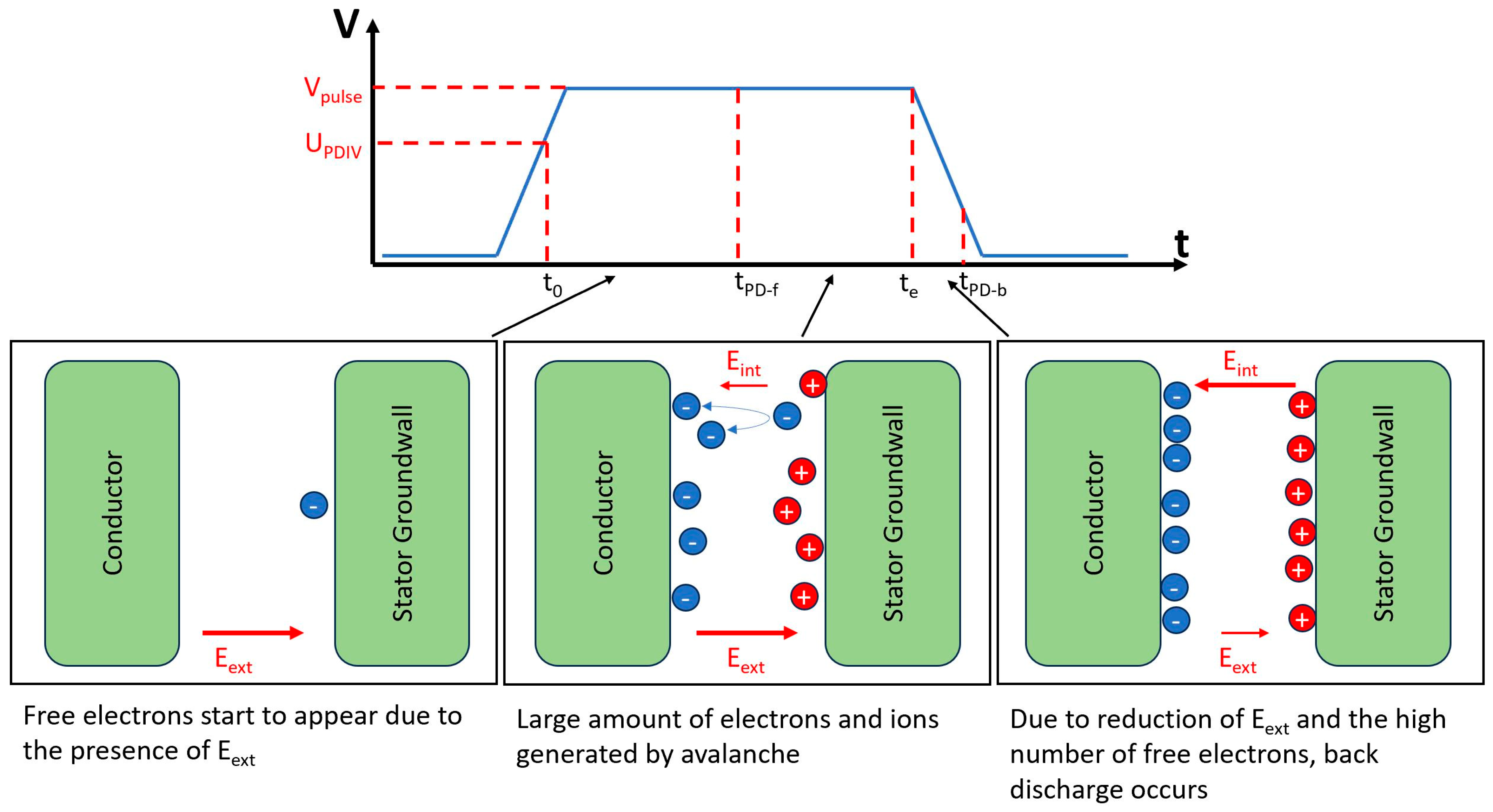
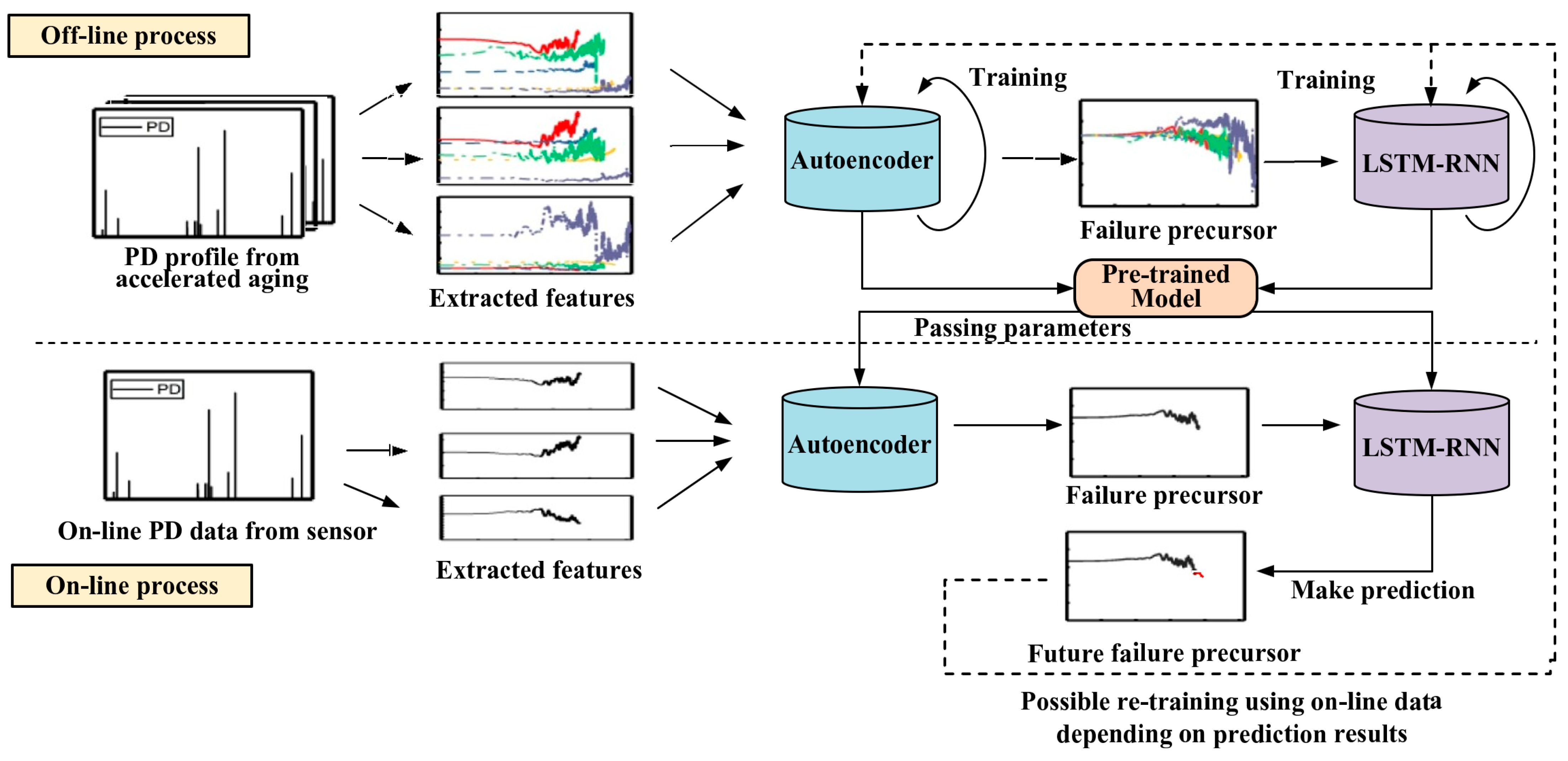

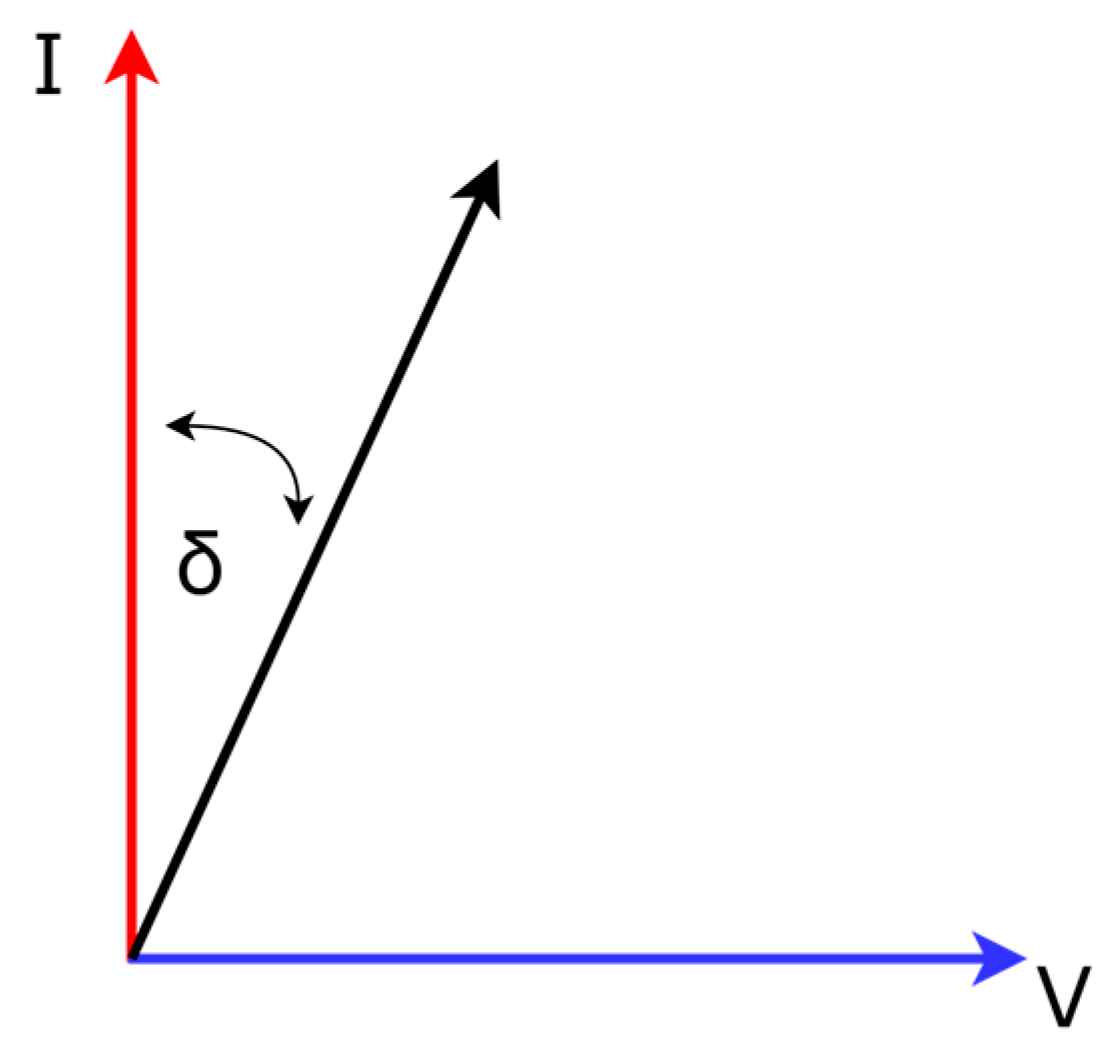

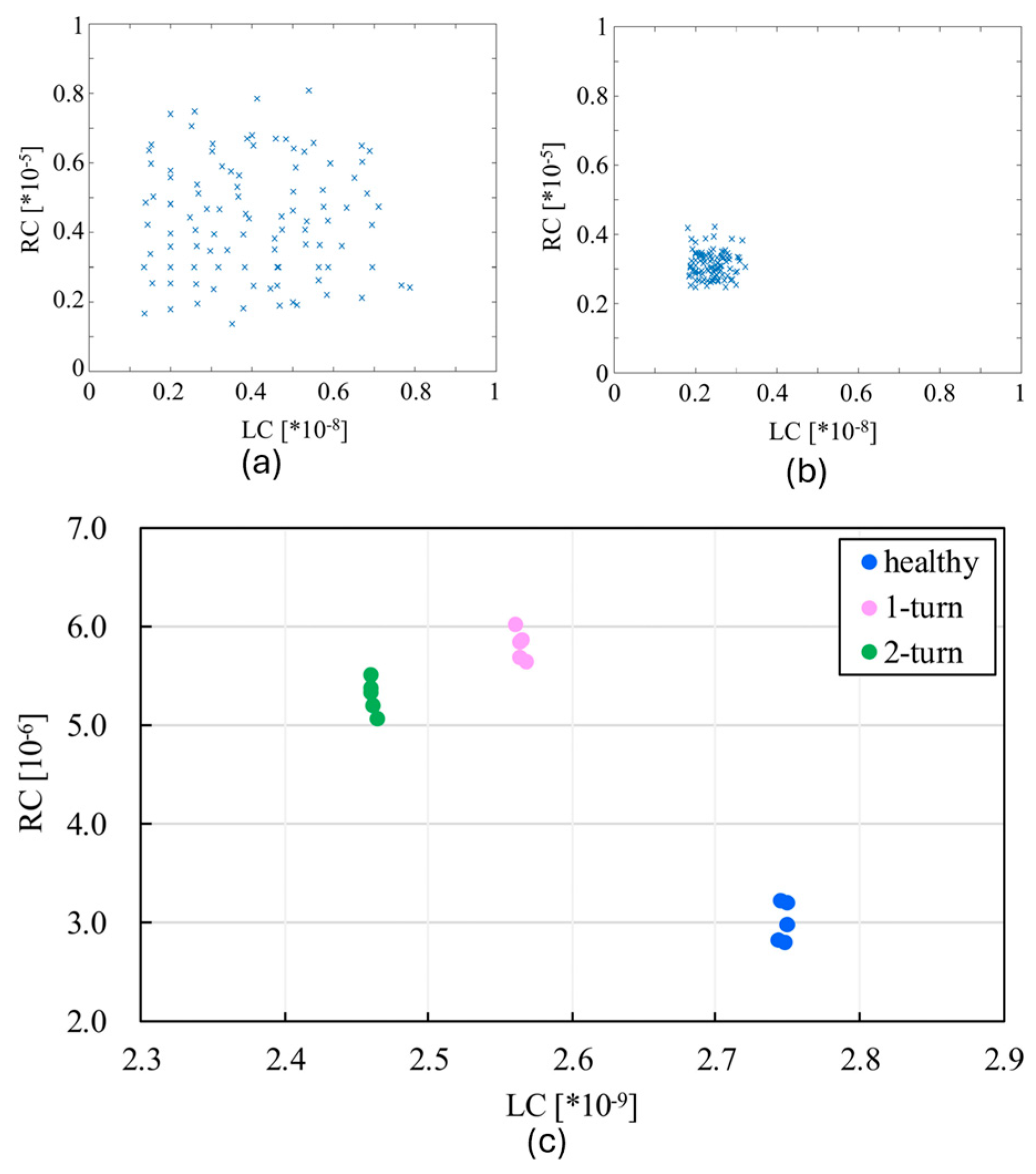



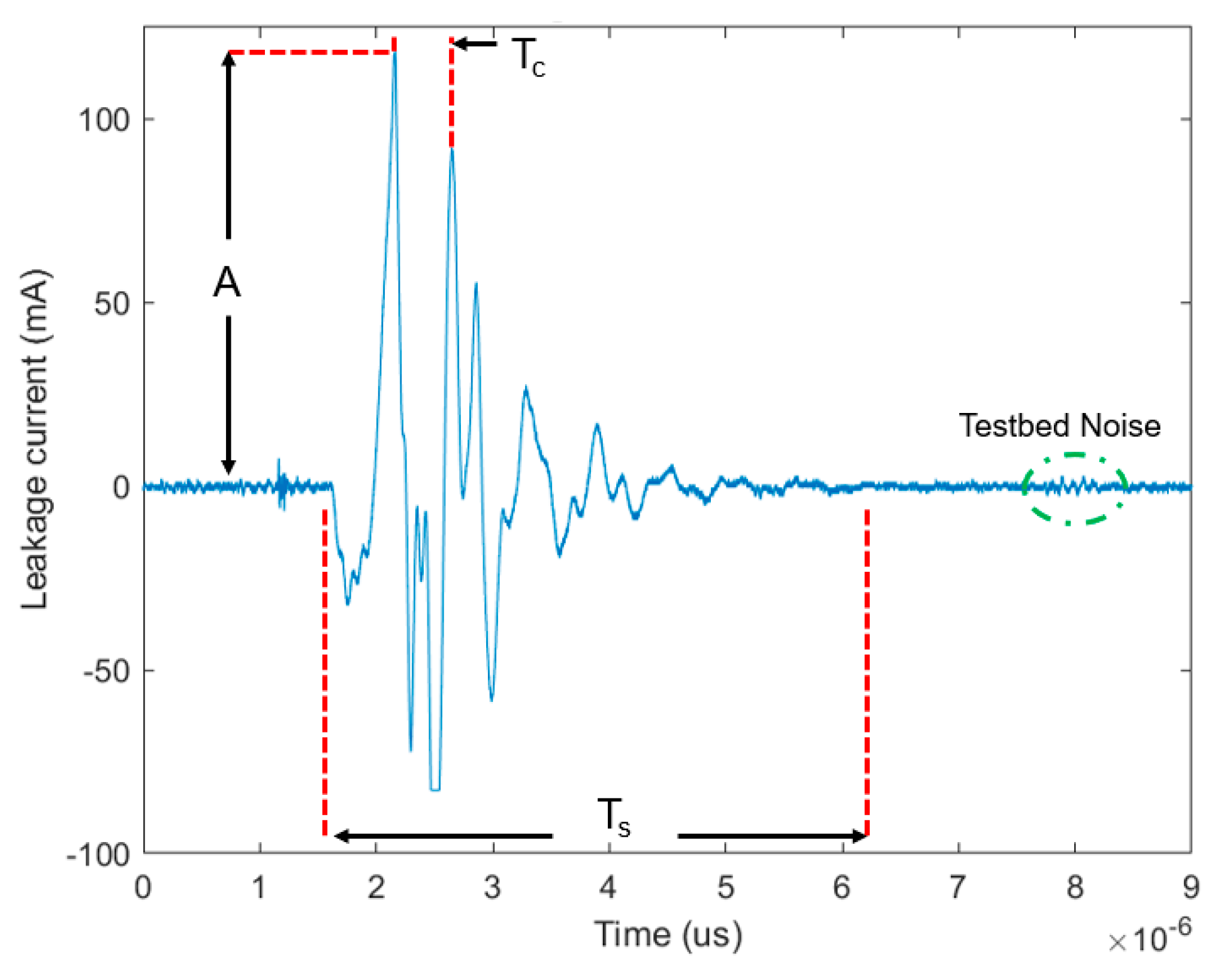


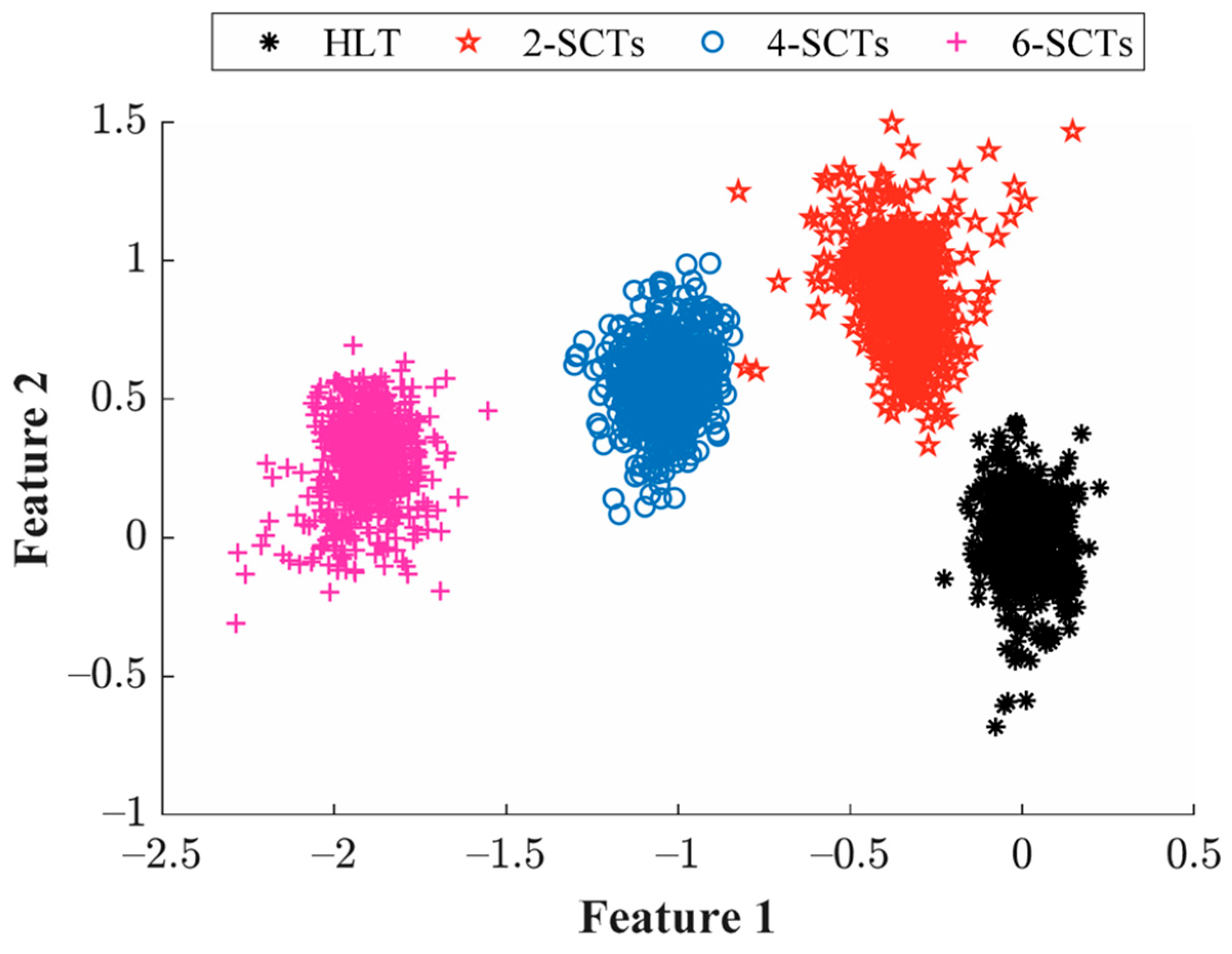
| Winding Rated Voltage (V) | Insulation Resistance Test Direct Voltage (V) |
|---|---|
| <100 | 500 |
| 1000–2500 | 500–1000 |
| 2501–5000 | 1000–2500 |
| 5001–12,000 | 2500–5000 |
| >12,1000 | 5000–10,000 |
| Name | Description | Performance Difficulty | Effectiveness |
|---|---|---|---|
| Insulation Resistance (IR) | Apply DC voltage for 1 min to measure leakage current | Easy | Only finds contamination and defects |
| Capacitance | Apply low or high voltage to measure winding capacitance to ground | Moderate | Moderately effective to find thermal or water leak problems |
| Dissipation Factor (DF) | Apply low or high voltage to measure insulation loss | Moderate | Moderately effective to find thermal or water leak problems |
| Partial Discharge (PD) | Directly detect PD pulse voltages at rated voltage | Difficult | Finds most problems except end winding vibration; for form-wound only. |
| Surge Test | Find turn and ground faults by measuring discontinuities in surge impedance | Difficult | Effective if close to dead short circuit |
| Degradation Type | Severity (%) | Simulated | Experimental | ||
|---|---|---|---|---|---|
| GW SoH | TT SoH | GW SoH | TT SoH | ||
| Healthy | 0 | 20.56 | 2.03 | 25.14 | 2.03 |
| TT Damage | 10 | 20.51 | 2.24 | 24.62 | - |
| 20 | 20.46 | 2.64 | 25.20 | 2.89 | |
| 30 | 20.42 | 3.32 | - | - | |
| 40 | 20.37 | 4.33 | - | - | |
| GW Damage | 10 | 23.57 | 2.25 | 26.69 | - |
| 20 | 25.88 | 2.54 | 26.95 | 2.73 | |
| 30 | 27.27 | 2.90 | - | - | |
| 40 | 29.53 | 3.34 | - | - | |
| Combined Damage | 10 | 23.52 | 2.61 | 26.70 | - |
| 20 | 25.63 | 3.93 | 28.69 | 3.03 | |
| 30 | 27.06 | 5.98 | - | - | |
| 40 | 29.39 | 7.81 | - | - | |
| Description | ANN | ANN-GA | ANN-GSA |
|---|---|---|---|
| 0.173 | 0.067 | 0.014 |
| Experiment | Cross Validation | Training | Testing | Test Accuracy |
|---|---|---|---|---|
| Experiment 1 | Cross Validation 1 | 9 Healthy + 3 Faulty (Faulty: Stator 6) | 6 Healthy + 6 Faulty (Faulty: Stator 7 and 8) | 95% |
| Cross Validation 2 | 9 Healthy + 3 Faulty (Faulty: Stator 7) | 6 Healthy + 6 Faulty (Faulty: Stator 7 and 8) | 100% | |
| Cross Validation 3 | 9 Healthy + 3 Faulty (Faulty: Stator 8) | 6 Healthy + 6 Faulty (Faulty: Stator 6 and 7) | 89% | |
| Overall Experiment accuracy | 94.7% | |||
| Experiment 2 | Cross Validation 1 | 9 Healthy + 3 Faulty (Faulty: Stator 6) | 6 Healthy + 6 Faulty (Faulty: Stator 7 and 8) | 100% |
| Cross Validation 2 | 9 Healthy + 3 Faulty (Faulty: Stator 7) | 6 Healthy + 6 Faulty (Faulty: Stator 7 and 8) | 100% | |
| Cross Validation 3 | 9 Healthy + 3 Faulty (Faulty: Stator 8) | 6 Healthy + 6 Faulty (Faulty: Stator 6 and 7) | 100% | |
| Overall Experiment accuracy | 100% |
| Method | Sensitivity | Downtime | Accuracy | Key Limitations | References |
|---|---|---|---|---|---|
| Partial Discharge (PD) | High | Low | ±15% | Susceptible to noise; might not detect early degradation | [32,33,34,35,36] |
| Insulation Resistance (IR) | Low | Medium | ±25% | Strongly dependent on temperature, humidity, and contamination | [48,56,57,58] |
| Surge Testing | Moderate | High | ±20% | Limited turn-to-turn insulation diagnosis in early stages | [18,53,59,60] |
| Tan-Delta/Dissipation Factor (DF) | Moderate | Medium | ±15% | Requires stable test voltage; surface leakage interference | [49,53,55] |
| Insulation Capacitance | Moderate | Low | ±10% | Temperature-dependent; not reliable for early degradation | [24,53,54] |
| Impedance-Based Analysis | High | None | ±3–6% | Requires accurate modeling | [75,77,78] |
| Current-Based Analysis | Moderate | None | ±5–10% | Requires clean signals; may miss localized faults | [72,74,82,83,84] |
| Insulation State Indicator (ISI) | High | None | ±8% | Heavily model-dependent; requires historic baseline | [84,94,95,96] |
| Wavelet Particle Decomposition (WPD) | High | None | ±6% | Needs high-resolution signal; computationally intensive | [61,92,93] |
| AI-Based Analysis | Very High | None | ±1–6% | Requires large training dataset; performance drops with unseen failure modes; interpretability issues | [46,97,98,99,100,104] |
Disclaimer/Publisher’s Note: The statements, opinions and data contained in all publications are solely those of the individual author(s) and contributor(s) and not of MDPI and/or the editor(s). MDPI and/or the editor(s) disclaim responsibility for any injury to people or property resulting from any ideas, methods, instructions or products referred to in the content. |
© 2025 by the authors. Licensee MDPI, Basel, Switzerland. This article is an open access article distributed under the terms and conditions of the Creative Commons Attribution (CC BY) license (https://creativecommons.org/licenses/by/4.0/).
Share and Cite
Sirizzotti, B.; Addae, D.; Agamloh, E.; von Jouanne, A.; Yokochi, A. A Review of Stator Insulation State-of-Health Monitoring Methods. Energies 2025, 18, 3758. https://doi.org/10.3390/en18143758
Sirizzotti B, Addae D, Agamloh E, von Jouanne A, Yokochi A. A Review of Stator Insulation State-of-Health Monitoring Methods. Energies. 2025; 18(14):3758. https://doi.org/10.3390/en18143758
Chicago/Turabian StyleSirizzotti, Benjamin, Daniel Addae, Emmanuel Agamloh, Annette von Jouanne, and Alex Yokochi. 2025. "A Review of Stator Insulation State-of-Health Monitoring Methods" Energies 18, no. 14: 3758. https://doi.org/10.3390/en18143758
APA StyleSirizzotti, B., Addae, D., Agamloh, E., von Jouanne, A., & Yokochi, A. (2025). A Review of Stator Insulation State-of-Health Monitoring Methods. Energies, 18(14), 3758. https://doi.org/10.3390/en18143758






